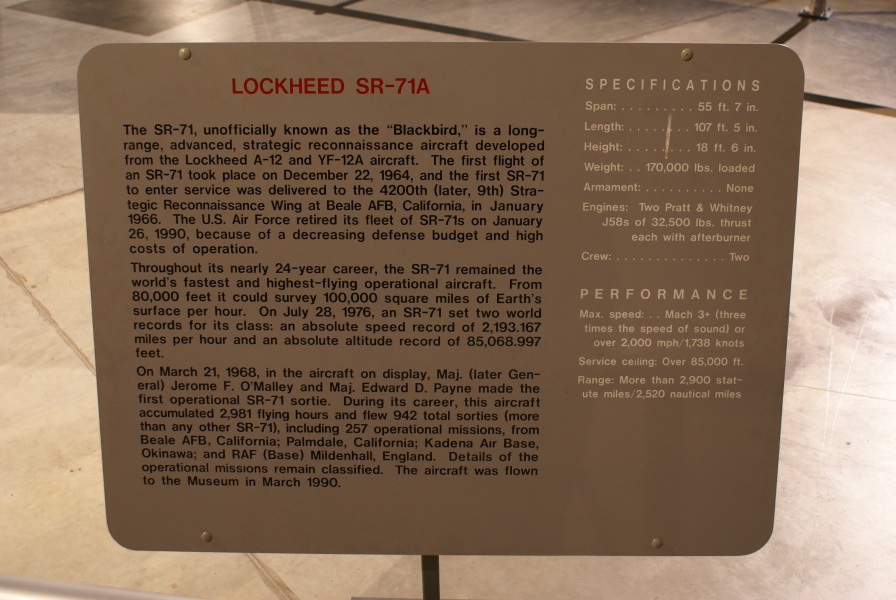| Prev |
heroicrelics.org Air Force Museum Site Index SR-71 Gallery |
Next |
dsca3495.jpg
The sign accompanying the plane. It reads
Lockheed SR-71A
The SR-71, unofficially known as the "Blackbird," is a long-range, advanced, strategic reconnaissance aircraft developed from the Lockheed A-12 and YF-12A aircraft. The first flight of the SR-71 took place on December 22, 1964, and the first SR-71 to enter service was delivered to the 4200th (later, 9th) Stategic Reconnaissance Wing at Beale AFB, California, in January 1966. The U.S. Air Force retired its fleet of SR-71s on January 26, 1990, because of a decreasing defense budget and high costs of operation.
Throughout its nearly 24-year career, the SR-71 remained the world's fastest and highest-flying operational aircraft. From 80,000 feet it could survey 100,000 square miles of Earth's surface per hour. On July 28, 1976, an SR-71 set two world records for its class: an absolute speed record of 2,193.167 miles per hour and an absolute altitude record of 85,068.997 feet.
On March 21, 1968, in the aircraft on display, Maj. (later General) Jerome F. O'Malley and Maj. Edward D. Payne made the first operational SR-71 sortie. During its career, this aircraft accumulated 2,981 flying hours and flew 942 total sorties (more than any other SR-71), including 257 operational missions, from Beale AFB, California; Palmdale, California; Kadena Air Base, Okinawa; and RAF (Base) Mildenhall, England. Details of the operational missions remain classified. The aircraft was flown to the Museum in March 1990.
Specifications Span: 55 ft. 7 in. Length: 107 ft., 5 in. Height: 18 ft. 6 in. Weight: 170,000 lbs. loaded Armament: None Engines: Two Pratt & Whitney J58s of 32,500 lbs. thrust each, with afterburners Crew: Two
Performance Max. Speed: Mach 3+ (three times the speed of sound) or over 2,000 mph/1,738 knots Ceiling: Above 85,000 ft Range: More than 2,900 statute miles/2,520 nautical miles

| Time picture taken | Wed May 21 09:39:06 2014 |
| Location picture taken | Cold War Gallery Air Force Museum Dayton, OH |
| Prev | SR-71 Gallery | Next |